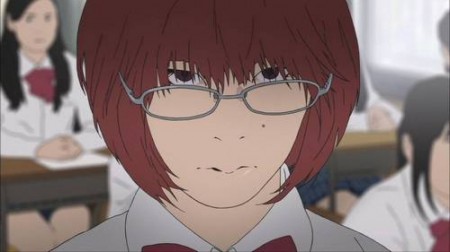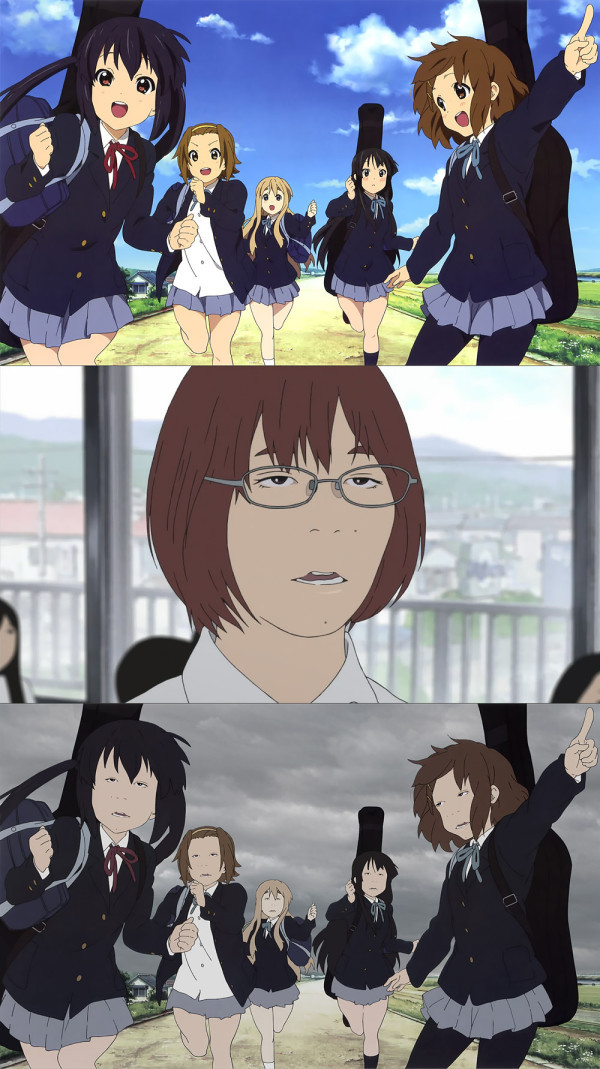Ask John: Is the Criticism of Aku no Hana Justified?

Question:
What is your take on the Aku no Hana controversy? Few shows have generated such amount of animosity and criticism with just the first episode alone. So, why do you think Western fandom hated Aku no Hana so much and is that hate justified?
Answer:
Many veteran anime viewers eventually develop an interest in esoteric, vintage, and unusual anime. Having watched so much mainstream and conventional anime and become infatuated with the art form, naturally these veteran fans want to broaden their horizon both with something new and something more unique and unusual. Since the anime production industry doesn’t produce too many of these sort of unusual, experimental shows each year, otaku tend to have high expectations for the instances that do get released. I’m personally in that exact sort of situation as a fan. I’ve watched all five broadcast episodes of Aku no Hana, so far, and feel compelled to continue watching the program because it’s likely to be one of the most unusual and provocative anime of the year. But I don’t especially like it. Evidently much of the otaku community in Japan and abroad has homed in on the show’s visual design as a cause for incisive criticism. I also have to concede the argument, but my personal aversion to the show has more to do with its characters and story than its visual design.
Aku no Hana director Hiroshi Nagahama has worked on brilliant anime including Shoujo Kakumei Utena and Ima, Soko ni Iru Boku, and directed Mushishi, one of the finest anime series ever made. So I have faith that Nagahama is a skilled, creative, and thoughtful artist and director. I presume that the decision to rotoscope animate the Aku no Hana television series, particularly the way it’s being done, is a conscious effort to make the show emblematic and archetypal. Making the show look realistic while still looking abstract theoretically allows viewers to empathize with the story and characters and place themselves into the show, relate the show to their own lives and personalities. But while the theory is sound, the execution doesn’t seem to be entirely successful. The very nature of experimental anime is that the experiment is not always successful. The rotoscoping applied to Aku no Hana isn’t as attractive or artistically creative as that which was used on the 2011 Otona Joshi no Anime Time: Kawamo wo Suberu Kaze TV special. In fact, the animation design on Aku no Hana frequently comes across as rushed and incomplete. A sense of anonymity would be perfectly suited to the show if the show was distinctly supposed to be a social parable, like last year’s Shiranpuri anime TV special from studio Shirogumi. But Aku no Hana isn’t strictly a morality tale with archetypal characters. The show is a harsh, critical drama about specific characters with specific, individual personalities that are relatable to broader social issues. In effect, the show is trying to simultaneously exist as two opposing types of narrative. The series wants to be a fictional drama and also a social parable. Anime including Evangelion and the Black Rock Shooter television series can be fictional drama that incorporate social critique, but they’re not social parable. In trying to pull in two opposing directions, the Aku no Hana television series only succeeds at compromising both efforts.
The show appears to be a story about a teen boy who makes an impulsive mistake then continues to let that mistake spiral out of control. But the true core of the show’s conflict occurs before Kasuga’s bad decision in the second episode, and before the first episode even begins. Like countless teen boys struggling with their pubescent identity and sense of self-identity, Takao Kasuga suffers from a true, realistic form of “chyuunibyo.” Rather than envisioning himself as a demon lord, he’s thoroughly convinced himself that he’s a suffering aesthete stifled by the narrow-minded mundanity of his surroundings. He’s convinced himself that since he reads esoteric French literature, he must be more sensitive, more idealistic, more high-minded, and more “pure” than the earthbound plebians that surround him. Perhaps influenced by the literature he reads, he’s adopted a literary madonna/whore complex. Saeki is his chaste, angelic madonna; all other women, like Nakamura and his classmate Ai are petty, selfish, cruel and vindictive. In the series’ third episode, Kasuga defends Nakamura, likely not because he cares about her but because his own sense of being better than everyone else demands that he stand up against obvious injustice. But Kasuga is so intently absorbed in his own delusion that he’s entirely self-centered. In his mind Saeki only exists as a compliment to himself. Nakamura only exists as a thorn in his side. His classmates only register to him as people with the potential to ostracize him. He firmly believes that Saeki will love and respect him if she can just see his honorable and chivalrous “true self” when, in fact, if she actually knew what he’d done and what secrets he keeps, she’d probably be rightfully upset and disgusted. Kasuga is so enraptured in his own self-serving delusion that he literally can’t see himself objectively and comprehend the way other people perceive him. Sawa Nakamura’s mordant evaluation of Kasuga’s personality is also probably too harsh, but she’s slightly closer to accurate than he is. Kasuga is simply an ordinary, awkward teen boy, but he can’t or won’t recognize himself and his own realistic circumstances.
Thematically Aku no Hana is insightful and incisive. Kasuga’s delusional personality is probably typical of many high school age boys. But universality doesn’t make his personality flaw pleasant. I find myself forcing myself to watch the weekly episodes out of academic curiosity instead of eager joyful appreciation. I’m continuing to watch the show out of a sense of obligation to gain first-hand knowledge of this highly unusual anime production instead of watching the show because I enjoy watching it. Two weeks ago, the live-action footage that the show is based on leaked onto NicoNico. The show’s attempt at realism and its effort to illustrate unsavory adolescent foolishness make me personally wish that the adaptation had been simply left in live-action and broadcast as a drama instead of broadcast as an anime. I presume that the show’s rotoscoped art design is intended to make the show impressionistic, to make the characters stand-ins for countless numbers of average high school kids around the world. But the effort isn’t working. Instead of making the characters archetypal representations, the rough, impressionistic art design only adds a layer of distraction that distances viewers instead of engaging them. With the art design the way it is, the characters aren’t stylized enough to be iconic representations, nor are they realistic enough to be relateable dramatic characters. Comparisons of Aku no Hana to other conventional school-life anime are unfair because Aku no Hana has much more thematically and dramatically going on than typical school-life anime. Aku no Hana isn’t supposed to be a cute slice-of-life show like K-On! or Little Busters nor a schoolyard comedy like Seitokai Yakuindomo or Seitokai no Ichizon. So comparing it to them is unfair. But Aku no Hana is comparable to other esoteric anime like Otona Joshi no Anime Time: Kawamo wo Suberu Kaze and Kuchu Buranko that have also used rotoscoping to much more organic and effective result.
Add a Comment
You must be logged in to post a comment.



John usually gives a thoughtful and fair enough response to these questions. I, however, am just some dude, and here is my response.
HELL NO, THE CRITICISMS AREN’T JUSTIFIED! This is far worse criticism than haters of Naruto who down the show, even though it’s been 200 episodes since they’ve even seen an episode of it.
The hatred towards Flowers of Evil is ridiculous because it doesn’t go beyond the skin. i can understand these people who want all their anime to look the same, to look cute, to have the “house style.”
If you can get over it, Flowers of Evil is PHENOMENAL! I hesitate to call it a masterpiece, because it hasn’t even ended yet, but this is easily the best of the season, and possibly 2013. I love it that much. I think that the risks taken here were revolutionary, and there is no other show out here like this. I’m hyperboling all over the place!
Are you sure the first Otona Joshi no Anime Time short is rotoscopy beyond the art-filtered photo backrounds? The character animation looks like plain old realist-school animation to me. I’m reminded of how some film critics incorrectly called Jin Roh a product of rotoscopy back in its day.
_”Two weeks ago, the live-action footage that the show is based on leaked onto NicoNico. The show’s attempt at realism and its effort to illustrate unsavory adolescent foolishness make me personally wish that the adaptation had been simply left in live-action and broadcast as a drama instead of broadcast as an anime. I presume that the show’s rotoscoped art design is intended to make the show impressionistic, to make the characters stand-ins for countless numbers of average high school kids around the world. But the effort isn’t working.”_
My feelings are also mixed about the show’s process. I like how rotoscopy brings an unnerving sense of immediate reality to the world from which the protagonist can’t escape. I loved the scene where he was frantically running around outside unable to throw away the gym uniform. Rotoscopy happens to be a great way to illustrate the guilt-ridden nervous wreck that he’s become. That’s what rotoscopy brings to the anime table.
But for the opposite argument, what does animation bring to the live-action table, it’s hard to say. Rotoscope films like Waking Life and A Scanner Darkly (as well as the traditionally-animated but realist-school Millennium Actress) use animation to blur the line between reality and fantasy– subjectivity and objectivity. I don’t really see that happening in Aku no Hana so I don’t know what the animation layer is for. It makes a great marketing tool because, as an anime fan, I wouldn’t have watched the show if it were just yet another manga-based j-drama.
As for the story itself, I rather enjoy it. “Do you remember your puberty?” reads one of the post-episode cards. At least for me, the show does a good job summoning those feelings of angst, alienation and insecurity.
The cards are so great!
“Are you sure the first Otona Joshi no Anime Time short is rotoscopy…?”
Actually, no, I’m not. I may be wrong, but I do think that regardless the first Otona Joshi no Anime Time special serves as an example of an art design style that’s comparable to Aku no Hana but much more attractive to look at.